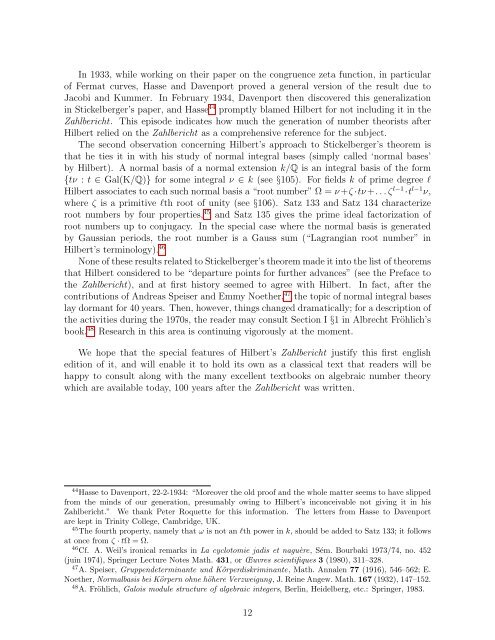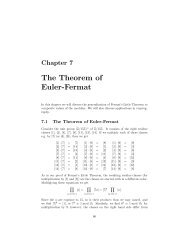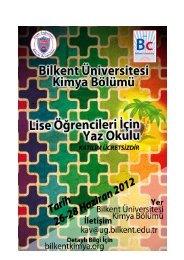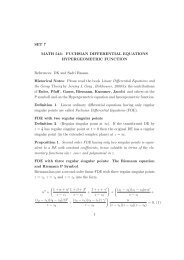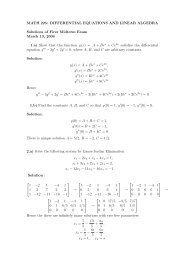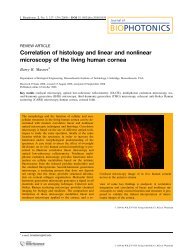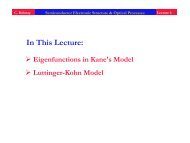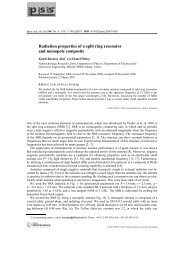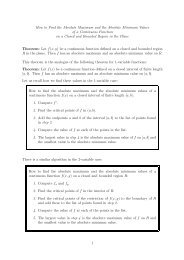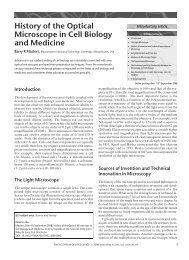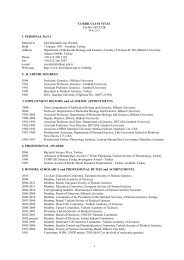Introduction to the English Edition of Hilbert's Zahlbericht
Introduction to the English Edition of Hilbert's Zahlbericht
Introduction to the English Edition of Hilbert's Zahlbericht
You also want an ePaper? Increase the reach of your titles
YUMPU automatically turns print PDFs into web optimized ePapers that Google loves.
In 1933, while working on <strong>the</strong>ir paper on <strong>the</strong> congruence zeta function, in particular<br />
<strong>of</strong> Fermat curves, Hasse and Davenport proved a general version <strong>of</strong> <strong>the</strong> result due <strong>to</strong><br />
Jacobi and Kummer. In February 1934, Davenport <strong>the</strong>n discovered this generalization<br />
in Stickelberger’s paper, and Hasse 44 promptly blamed Hilbert for not including it in <strong>the</strong><br />
<strong>Zahlbericht</strong>. This episode indicates how much <strong>the</strong> generation <strong>of</strong> number <strong>the</strong>orists after<br />
Hilbert relied on <strong>the</strong> <strong>Zahlbericht</strong> as a comprehensive reference for <strong>the</strong> subject.<br />
The second observation concerning Hilbert’s approach <strong>to</strong> Stickelberger’s <strong>the</strong>orem is<br />
that he ties it in with his study <strong>of</strong> normal integral bases (simply called ‘normal bases’<br />
by Hilbert). A normal basis <strong>of</strong> a normal extension k/Q is an integral basis <strong>of</strong> <strong>the</strong> form<br />
{tν : t ∈ Gal(K/Q)} for some integral ν ∈ k (see §105). For fields k <strong>of</strong> prime degree ℓ<br />
Hilbert associates <strong>to</strong> each such normal basis a “root number” Ω = ν +ζ ·tν +. . . ζ l−1 ·t l−1 ν,<br />
where ζ is a primitive ℓth root <strong>of</strong> unity (see §106). Satz 133 and Satz 134 characterize<br />
root numbers by four properties, 45 and Satz 135 gives <strong>the</strong> prime ideal fac<strong>to</strong>rization <strong>of</strong><br />
root numbers up <strong>to</strong> conjugacy. In <strong>the</strong> special case where <strong>the</strong> normal basis is generated<br />
by Gaussian periods, <strong>the</strong> root number is a Gauss sum (“Lagrangian root number” in<br />
Hilbert’s terminology). 46<br />
None <strong>of</strong> <strong>the</strong>se results related <strong>to</strong> Stickelberger’s <strong>the</strong>orem made it in<strong>to</strong> <strong>the</strong> list <strong>of</strong> <strong>the</strong>orems<br />
that Hilbert considered <strong>to</strong> be “departure points for fur<strong>the</strong>r advances” (see <strong>the</strong> Preface <strong>to</strong><br />
<strong>the</strong> <strong>Zahlbericht</strong>), and at first his<strong>to</strong>ry seemed <strong>to</strong> agree with Hilbert. In fact, after <strong>the</strong><br />
contributions <strong>of</strong> Andreas Speiser and Emmy Noe<strong>the</strong>r, 47 <strong>the</strong> <strong>to</strong>pic <strong>of</strong> normal integral bases<br />
lay dormant for 40 years. Then, however, things changed dramatically; for a description <strong>of</strong><br />
<strong>the</strong> activities during <strong>the</strong> 1970s, <strong>the</strong> reader may consult Section I §1 in Albrecht Fröhlich’s<br />
book. 48 Research in this area is continuing vigorously at <strong>the</strong> moment.<br />
We hope that <strong>the</strong> special features <strong>of</strong> Hilbert’s <strong>Zahlbericht</strong> justify this first english<br />
edition <strong>of</strong> it, and will enable it <strong>to</strong> hold its own as a classical text that readers will be<br />
happy <strong>to</strong> consult along with <strong>the</strong> many excellent textbooks on algebraic number <strong>the</strong>ory<br />
which are available <strong>to</strong>day, 100 years after <strong>the</strong> <strong>Zahlbericht</strong> was written.<br />
44Hasse <strong>to</strong> Davenport, 22-2-1934: “Moreover <strong>the</strong> old pro<strong>of</strong> and <strong>the</strong> whole matter seems <strong>to</strong> have slipped<br />
from <strong>the</strong> minds <strong>of</strong> our generation, presumably owing <strong>to</strong> Hilbert’s inconceivable not giving it in his<br />
<strong>Zahlbericht</strong>.” We thank Peter Roquette for this information. The letters from Hasse <strong>to</strong> Davenport<br />
are kept in Trinity College, Cambridge, UK.<br />
45The fourth property, namely that ω is not an ℓth power in k, should be added <strong>to</strong> Satz 133; it follows<br />
at once from ζ · tΩ = Ω.<br />
46Cf. A. Weil’s ironical remarks in La cyclo<strong>to</strong>mie jadis et naguère, Sém. Bourbaki 1973/74, no. 452<br />
(juin 1974), Springer Lecture Notes Math. 431, or Œuvres scientifiques 3 (1980), 311–328.<br />
47A. Speiser, Gruppendeterminante und Körperdiskriminante, Math. Annalen 77 (1916), 546–562; E.<br />
Noe<strong>the</strong>r, Normalbasis bei Körpern ohne höhere Verzweigung, J. Reine Angew. Math. 167 (1932), 147–152.<br />
48A. Fröhlich, Galois module structure <strong>of</strong> algebraic integers, Berlin, Heidelberg, etc.: Springer, 1983.<br />
12


